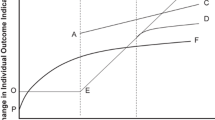Abstract
The social contexts of urban neighborhoods provide a dimension to urban politics which extends beyond the characteristics of discrete political actors. This article shows that the political effects of these spatially defined social environments depend upon individual characteristics, as well as neighborhood properties; the contextual effects are not constant across individual categories or within individual categories across context. Using Democratic identification as the dependent variable, two reactions to context are demonstrated: conflict and assimilation. The interdependency of individual characteristics and contextual properties determines (1) which reaction occurs where for which individuals, and (2) the extent of political differences between occupational classes.
Similar content being viewed by others
Bibliography
Berelson, Bernard, R., Paul F. Lazarsfeld, and William. N. McPhee (1954).Voting: A Study of Opinion Formation in a Presidential Election. Chicago: University of Chicago Press.
Berger, Bennett M. (1960).Working Class Suburb: A Study of Auto Workers in Suburbia. Berkeley: University of California Press.
Butler, David and Donald Stokes (1974).Political Change in Britain: The Evolution of Electoral Choice. New York: St. Martin's.
Coleman, James S. (1964).Introduction to Mathematical Sociology. New York: Free Press.
Cox, Kevin R. (1974), “The Spatial Structuring of Information Flow and Partisan Attitudes.” In Mattei Dogan and Stein Rokkan (Eds.),Social Ecology. Cambridge, Mass.: M.I.T. Press, pp. 157–186.
Finifter, Ada W. (1974). “The Friendship Group as a Protective Environment for Political Deviants.”American Political Science Review (June), 607–625.
Foladare, Irving S. (1968). “The Effect of Neighborhood on Voting Behavior.”Political Science Quarterly (December), 516–529.
Gans, Herbert J. (1967).The Levittowners: Ways of Life and Politics in a New Suburban Community. New York: Patheon Books.
Hauser, Robert M. (1974). “Contextual Analysis Revisited.”Sociological Methods and Research (February), 365–375.
Hanushek, Eric A., and John E. Jackson. (1977).Statistical Methods for Social Scientists. New York: Academic Press.
Huckfeldt, R. Robert (1979). “Political Participation and the Neighborhood Social Context.”American Journal of Political Science (August), 579–592.
Kelley, Harold H. (1952). “Two Functions of Reference Groups.” In Guy E. Swanson, Theodore M. Newcomb, and Eugene L. Hartley (Eds.),Readings in Social Psychology. New York: Henry Holt. Pages 410–414.
Key, V. O., Jr. with the assistance of Alexander Heard (1949).Southern Politics: In State and Nation. New York: Knopf.
Langton, Kenneth P., and Ronald Rapoport (1975) “Social Structure, Social Context, and Partisan Mobilization: Urban Workers in Chile.”Comparative Political Studies (October), 318–344.
McClosky, Herbert, and Harold E. Dahlgren. (1959). “Primary Group Influence on Party Loyalty. “American Political Science Review (December), 757–776.
McCrate, M. Martha, and J. Philip Miller. (1979). “The Predict Procedure.” In Jane T. Helwig (Ed.),SAS Supplemental Library User's Guide. Raleigh, N.C.: SAS Institute.
Orbell, John M. (1970). “An Information-Flow Theory of Community Influence.”Journal of Politics (May), 322–338.
Orbell, John M., and Kenneth S. Sherrill (1969). “Racial Attitudes and the Metropolitan Context: A Structural Analysis.”Public Opinion Quarterly (Spring), 46–54.
Przeworski, Adam (1974). “Contextual Models of Political Behavior.”Political Methodology (Winter), 27–61.
Przeworski, Adam, and Glaucio A. D. Soares (1971). “Theories in Search of a Curve: A Contextual Interpretation of Left Vote.”American Political Science Review (March), 51–68.
Schelling, Thomas C. (1972). “The Process of Residential Segregation: Neighborhood Tipping.” In Anthony H. Pascal (Ed.),Racial Discrimination in Economic Life. Lexington: Lexington Books of Health, 157–184.
Segal, David R., and Marshall W. Meyer (1974). “The Social Context of Political Partisanship.”Social Ecology. Edited by Mattei Dogan and Stein Rokkan. Cambridge, Mass.: M.I.T. Press, 217–232.
Sprague, John (1976). “Estimating a Boudon Type Contextual Model: Some Practical and Theoretical Problems of Measurement.”Political Methodology, 3: 333–353.
Suttles, Gerald D. (1972).The Social Construction of Communities. Chicago: University of Chicago Press.
Tingsten, Herbert (1963).Political Behavior: Studies in Election Statistics, Trans. Vilgot Hammarling. Totowa, N.J.: Bedminster. (Originally published in 1937.)
Wilson, Robert A. (1971). “Anomie in the Ghetto: A Study of Neighborhood Type, People, and Anomie.”American Journal of Sociology (July), 66–88.
Wright, Gerald C. (1976a). “Community Structure and Voting in the South.”Public Opinion Quarterly (Summer), 200–215.
Wright, Gerald C. (1976b). “Linear Models for Evaluating Conditional Relationships.”American Journal of Political Science (May), 349–373.
Author information
Authors and Affiliations
Additional information
An earlier version of this article was presented at the meetings of the Southern Political Science Association, Gatlinburg, Tennessee, November 1979, as Working Paper Number 1 of the Institute of Government Research at Louisiana State University.
Rights and permissions
About this article
Cite this article
Huckfeldt, R.R. Variable responses to neighborhood social contexts: Assimilation, conflict, and tipping points. Polit Behav 2, 231–257 (1980). https://doi.org/10.1007/BF00990481
Issue Date:
DOI: https://doi.org/10.1007/BF00990481




